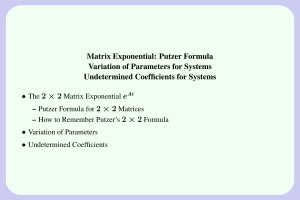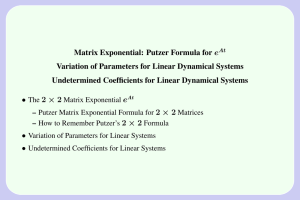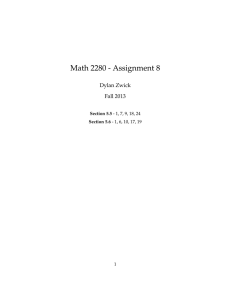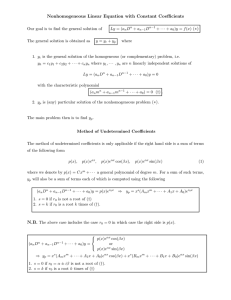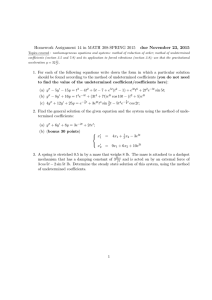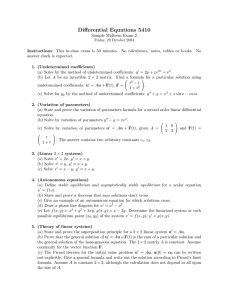Linear Dynamical Systems
advertisement
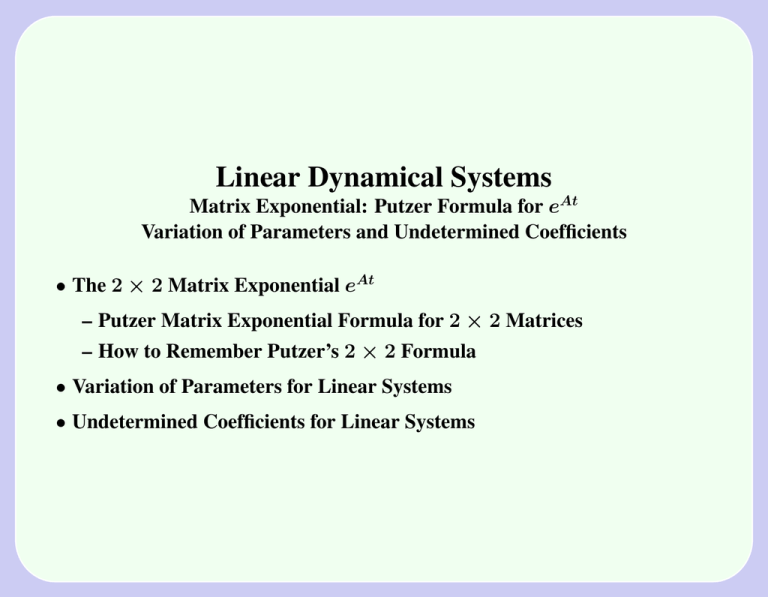
Linear Dynamical Systems
Matrix Exponential: Putzer Formula for eAt
Variation of Parameters and Undetermined Coefficients
• The 2 × 2 Matrix Exponential eAt
– Putzer Matrix Exponential Formula for 2 × 2 Matrices
– How to Remember Putzer’s 2 × 2 Formula
• Variation of Parameters for Linear Systems
• Undetermined Coefficients for Linear Systems
The 2 × 2 Matrix Exponential eAt
Definition. The matrix exponential eAt is the n × n matrix Φ(t) defined by
d
(1) dt
Φ = AΦ,
(2) Φ(0) = I .
Alternatively, Φ is the augmented matrix of solution vectors for the n problems
A~
vk , ~
vk (0) = column k of I , 1 ≤ k ≤ n.
d
~
v
dt k
=
Example. A 2 × 2 matrix A has exponential matrix eAt with columns equal to the
solutions of the two problems
d
d
~
dt~
dt~
~
v1(t) = A
~
v
(t),
~
v2(t) = A~
~
v2
(t),
1
~
~
v1(0)
=
1
0
~
~
v2(0)
=
0
1
Briefly, the 2 × 2 matrix Φ(t) = eAt satisfies the two conditions
(1)
d
dt
Φ(t) = AΦ(t),
(2) Φ(0) =
1 0
0 1
.
Putzer Matrix Exponential Formula for 2 × 2 Matrices
e
At
=e
λ1 t
I+
e λ1 t − e λ2 t
λ1 − λ2
(A − λ1I)
eAt = eλ1tI + teλ1t(A − λ1I)
e
At
at
= e cos bt I +
eat sin bt
b
(A − aI)
A is 2 × 2, λ1 6= λ2 real.
A is 2 × 2, λ1 = λ2 real.
A is 2×2, λ1 = λ2 = a+ib,
b > 0.
How to Remember Putzer’s 2 × 2 Formula
The expressions
eAt = r1(t)I + r2(t)(A − λ1I),
e λ1 t − e λ2 t
(1)
λ1 t
r1(t) = e , r2(t) =
λ1 − λ2
are enough to generate all three formulas. Fraction r2 is the d/dλ-Newton difference
quotient for r1 . Then r2 limits as λ2 → λ1 to the d/dλ-derivative teλ1 t . Therefore, the
formula includes the case λ1 = λ2 by limiting. If λ1 = λ2 = a + ib with b > 0,
then the fraction r2 is already real, because it has for z = eλ1 t and w = λ1 the form
r2(t) =
z−z
w−w
=
sin bt
b
.
Taking real parts of expression (1) gives the complex case formula.
Variation of Parameters
Theorem 1 (Variation of Parameters for Linear Systems)
Let A be a constant n × n matrix and ~
F(t) a continuous function near t = t0.
The unique solution ~
x(t) of the matrix initial value problem
~
x0(t) = A~
x(t) + ~
F(t),
~
x(t0) = ~
x0,
is given by the variation of parameters formula
Z t
At
At
(2)
e−rA~
F(r)dr.
~
x(t) = e ~
x0 + e
t0
Undetermined Coefficients
Theorem 2 (Polynomial Solutions)
Let f (t) be a polynomial of degree k. Assume A is an n × n constant invertible
P
tj
matrix. Then ~
u0 = A~
u + f (t)~c has a polynomial solution ~
u(t) = kj=0 ~cj j!
of
degree k with vector coefficients {~cj } given by the relations
~cj = −
k
X
f (i)(0)Aj−i−1~c,
0 ≤ j ≤ k.
i=j
Changes from nth Order Undetermined Coefficients. The nth order theory using Rule
I and Rule II is replaced by
Systems Rule for Undetermined Coefficients. Assume
d~
~
u
dt
~ (t).
= A~
~
u+F
~, F
~ 0, . . .. Don’t replace atoms by groups
Extract all Euler atoms from F
(Rule II). Instead, extend each existing group (Rule I) by adding m − 1
higher power terms xk (base atom) to the group, where m is the multiplicity
of the root for the base atom in the characteristic equation |A − rI| = 0.
The trial solution is a linear combination of the final atom list with vector
coefficients.
